
Sidhpur, India – Hidden in Gujarat’s arid heartland, the quiet town of Sidhpur harbors a colorful secret: a lane called Paris Galli where time seems frozen in an era of opulence and global grandeur.
Once home to the prosperous Dawoodi Bohra community, Sidhpur dazzles with rainbow-hued mansions—some teal, some baby pink, others pistachio green—lining narrow streets like an open-air museum of hybrid architecture.
These havelis, now largely abandoned, were built in the early 20th century by the Bohras, a Shia Muslim sect that arrived in India via Egypt, North Africa, and Yemen.
The mansions blend Neoclassical symmetry with Art Deco flair, Baroque intricacy, and native Indian design, showcasing the community’s global exposure and affluence.
Called Bohrawads or Vohrawads, these clusters reflect not just prosperity but a cultural dialogue between East and West, shaped by extensive trade networks.
Maharaja Sayajirao Gaekwad III of Baroda gifted land to the Bohras following their famine relief efforts, sparking a construction wave that followed urban planning rules influenced by Scottish planner Patrick Geddes.
The result was streetscapes with rhythmic uniformity, yet individual homes showed unique grillwork, stucco art, and pastel color palettes.
Most striking is the fusion of form and function: wooden structures suitable for earthquake zones, gabled roofs, carved “jharokha” windows, and English monograms on facades.
Homes often bore names like Zainab Mansion or Kagalwala Manor, signifying their original owners and adding personal touches to their stately grandeur.
The Zaveri house, known as the “House with 365 Windows,” once a marvel, now stands in decay, its facade blackened by time and neglect.
Teen Khuniya, or the Three-Cornered House, is another iconic structure with a rare triangular layout symbolizing architectural experimentation.
Photographer Sebastian Cortés documented the nostalgia and elegance of Sidhpur in his series “Time Present Time Past,” evoking both splendor and melancholy.
“These homes were built with love and a cosmopolitan vision, blending global ideas with local materials and craftsmanship,” said Cortés.
Zoyab A. Kadi, an architect and author born in Sidhpur, has written three books on the town’s legacy and continues to advocate for preservation.
He explains that the homes were designed to provide privacy for women, natural ventilation, and insulation suited to Gujarat’s climate.
The mansions are typically structured into five linear sections: a service area (dehli), central courtyard (chowk), multipurpose outer and inner rooms (pursaals), and a prime room (orda).
These design choices highlight both cultural customs and architectural intelligence, built for functionality, beauty, and social gatherings.
Despite their historic and artistic value, many homes are now crumbling as owners migrate abroad or abandon the structures entirely.
The neighborhood remains eerily quiet, with only a few Bohras walking the streets in colored hijabs and white caps.
Conservation architect Ashish Trambadia emphasizes the uniformity in rooflines and plinths, stating it gives Sidhpur a “unique character.”
The heritage homes represent an era when Sidhpur stood at the crossroads of commerce, cosmopolitanism, and community identity.
With each cracked cornice and faded shutter, the mansions echo stories of celebration, struggle, and forgotten elegance.
Today, Sidhpur sits outside mainstream tourism circuits, but its potential as a heritage site remains undeniable.
If restored, Paris Galli could become a cultural gem, offering a window into India’s syncretic architectural past.
As India modernizes, Sidhpur’s silent streets remind us that preservation is as vital as progress.
Only time will tell if the faded mansions of Sidhpur will rise again or continue to dissolve into memory and dust.




